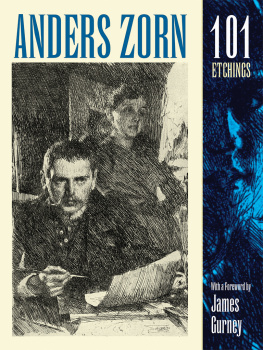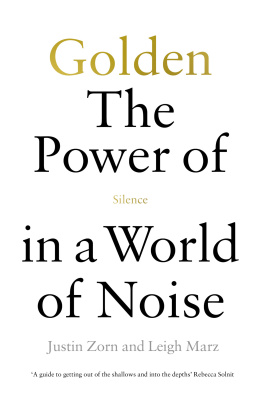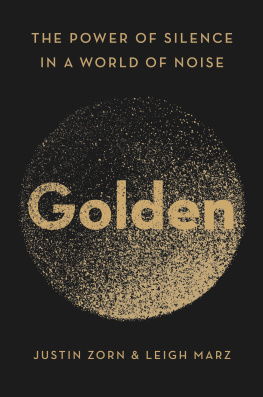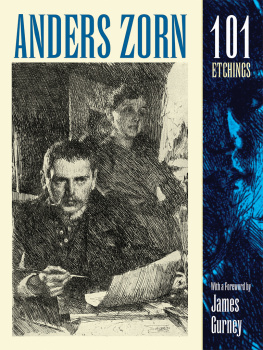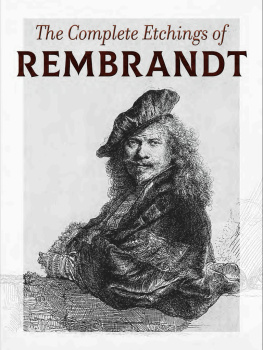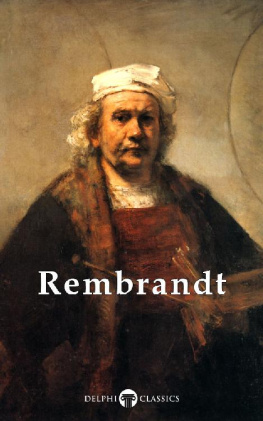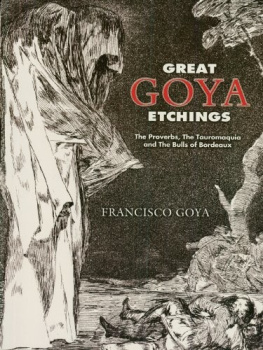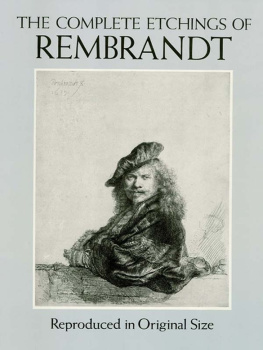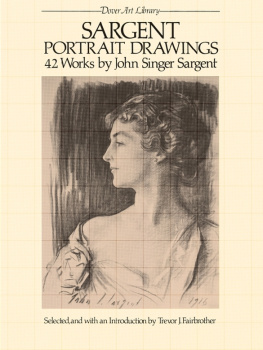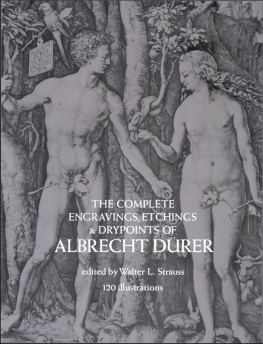
ANDERS ZORN
ETCHINGS
Foreword by James Gurney
Introduction by Ernest M. Lang
DOVER PUBLICATIONS, INC.
Mineola, New York
Copyright
Foreword copyright 2018 by James Gurney
Copyright 2018 by Dover Publications, Inc.
All rights reserved.
Bibliographical Note
This Dover edition, first published in 2018, is an unabridged republication of the illustrations as published by Verlag Ernst Arnold, Dresden, Germany, in 1922. The introduction by Ernest M. Lang has been taken from The Etchings of Anders Zorn, first published by Empire State Book Co., New York, in 1923. A new Foreword, written by James Gurney, has been specially prepared for the present edition.
Please note that some of the language in the original text contains cultural references characteristic of the era in which the etchings were created, and have been retained here for the sake of authenticity.
Library of Congress Cataloging-in-Publication Data
Names: Zorn, Anders, 18601920, artist. | Gurney, James, 1958 writer of foreword. | Lang, Ernest, 18991989, writer of introduction.
Title: Anders Zorn, 101 etchings / foreword by James Gurney ; introduction by Ernest M. Lang.
Other titles: Etchings of Anders Zorn.
Description: Mineola, New York : Dover Publications, Inc., 2018. | This Dover edition, first published in 2018, is an unabridged republication of the illustrations published by Verlag Ernst Arnold, Dresden, Germany, in 1922. The introduction by Ernest M. Lang has been taken from the edition published by Empire State Book Co., New York, in 1923.
Identifiers: LCCN 2018013142| ISBN 9780486828640 | ISBN 0486828646
Subjects: LCSH: Zorn, Anders, 18601920Themes, motives.
Classification: LCC NE2061.5.Z67 A4 2018 | DDC 709.2dc23
LC record available at https://lccn.loc.gov/2018013142
Manufactured in the United States by LSC Communications
82864601 2018
www.doverpublications.com
L IST OF PLATES
| Plate No. | Title | Date |
| 1916 |
| n.d. |
| 1883 |
| 1883 |
| 1889 |
| 1889 |
| 1889 |
| 1890 |
| 1891 |
| 1891 |
| 1891 |
| 1891 |
| 1891 |
| 1891 |
| 1891 |
| 1891 |
| 1891 |
| 1891 |
| 1892 |
| 1892 |
| 1893 |
| 1893 |
| 1893 |
| 1893 |
| 1894 |
| 1894 |
| 1894 |
| 1895 |
| 1895 |
| 1896 |
| 1896 |
| 1896 |
| 1897 |
| 1897 |
| 1897 |
| 1897 |
| 1898 |
| 1898 |
| 1898 |
| 1899 |
| 1899 |
| 1899 |
| 1900 |
| 1900 |
| 1900 |
| 1900 |
| 1900 |
| 1900 |
| 1900 |
| 1900 |
| 1901 |
| 1901 |
| 1901 |
| 1903 |
| 1903 |
| 1903 |
| 1903 |
| 1903 |
| 1903 |
| 1904 |
| 1904 |
| 1904 |
| 1904 |
| 1905 |
| 1906 |
| 1906 |
| 1906 |
| 1906 |
| 1906 |
| 1906 |
| 1906 |
| 1906 |
| 1907 |
| 1907 |
| 1907 |
| 1907 |
| 1907 |
| 1908 |
| 1909 |
| 1909 |
| 1909 |
| 1909 |
| 1910 |
| 1910 |
| 1911 |
| 1911 |
| 1912 |
| 1912 |
| 1912 |
| 1912 |
| 1913 |
| 1913 |
| 1913 |
| 1913 |
| 1914 |
| 1914 |
| 1914 |
| 1915 |
| 1917 |
| 1917 |
| 1918 |

James Gurney inspecting original Zorn prints at The Clark Art Institute in Massachusetts
Foreword: Encountering Zorns Etchings
by James Gurney
I discovered the alchemical art of etching when I was in high school. My father, an engineer at a research lab in Palo Alto, came home from work one day with a big jar of nitric acid and said I could experiment with it. I dropped a penny in the jar and watched the coin disappear in a stream of bubbles.
The experiments soon led to etching. Etching is a form of printmaking in which a copper plate is coated with a waxy resist material called a ground. You can scratch through the ground to expose bare metal lines on the plate. Immersing the plate in acid will cut grooves of varying depth in the exposed metal, depending on how long the plate remains in the acid. The printmaker then rubs ink into all the grooves and gently removes the ink from the smooth parts of the plate with a rag. When a piece of dampened paper is laid over the inked plate and cranked through a press under pressure, the ink transfers from the grooves to the paper. The line work on the resulting print superficially resembles a pen-and-ink drawing, but with an added atmospheric quality that is unique to the medium. By heating the inked plate and dragging a piece of cloth over the surface, the artist can coax some ink out of the grooves, yielding richer shading.
I made a few etchings, but I had no idea what the medium was capable of until the late 1970s, when I happened upon an exhibition at the UC Berkeley Art Museum. These were etchings by an artist I had never heard of, Anders Zorn. Since then I have sought out several opportunities to see Zorns original etchings in the prints and drawings rooms of museums. I am honored to be asked to reintroduce this landmark collection of Zorns finest etchings.
Today, Zorn is better known as a painter in oil and watercolor. Using those media, he created portraits and landscapes directly from life, as did his contemporaries John Singer Sargent and Joaqun Sorolla. Unlike those artists, Zorn earned a reputation in the realm of etching as well. During his lifetime, he was, by several accounts, better known for his prints than for his paintings.
A native of Sweden, Zorn learned the technique from Axel Herman Haig while visiting England. He didnt pay much attention to the English tradition, not even to James Abbott McNeill Whistler, who was famous for his etchings. Zorns strongest influence was Rembrandt van Rijn, whose work he studied during visits to Stockholm and Amsterdam. He bought a Rembrandt oil portrait and did an etching based on it, which he then used as a New Years greeting card. As Zorn grew wealthier, he collected etchings by Rembrandt. There were over two hundred in his estate when he died.
Zorn was fascinated by the ideas of impressionismnot just the superficial appearance of the loose strokes but also the realist aim of capturing the energy of modern life on location. Etching was well suited to capturing such fleeting effects. His experience with watercolor prepared him for etching, because both media lend themselves to free improvisation and minimal revision. In his etchings he tended to avoid gradual or indirect techniques such as aquatint or the roulette.
Next page
